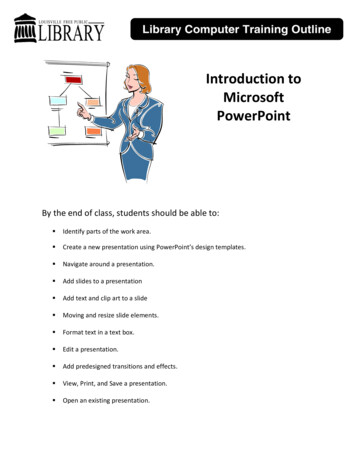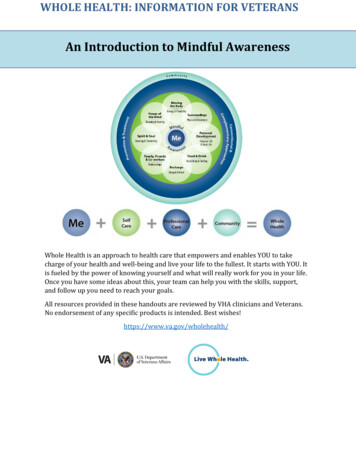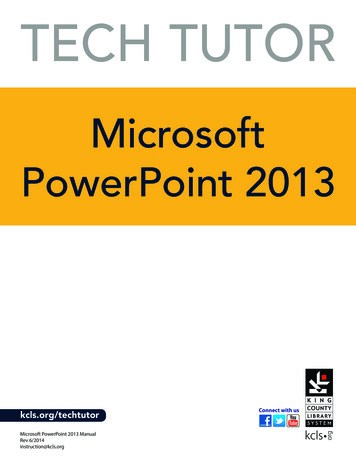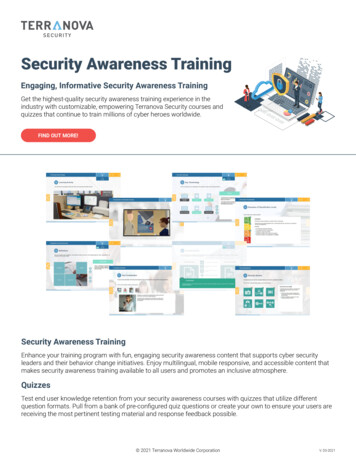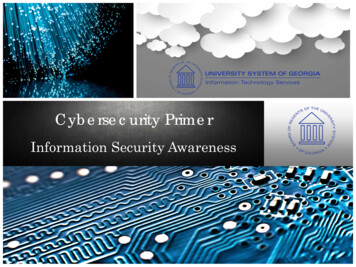
Transcription
Cybersecurity PrimerInformation Security Awareness
Importance of Cybersecurity The internet allows an attacker to work fromanywhere on the planet. Risks caused by poor security knowledge and practice: Identity TheftMonetary TheftLegal Ramifications (for yourself and your organization)Sanctions or termination if policies are not followed According to the SANS Institute, the top vectors forvulnerabilities available to a cyber criminal are: Web BrowserIM ClientsWeb ApplicationsExcessive User Rights2
Cybersecurity is SafetySecurity: We must protect our computers and datain the same way that we secure the doors toour homes.Safety: We must behave in ways that protect usagainst risks and threats that come with technology.3
User AwarenessCracker:Computer-savvyprogrammer createsattack softwareScript Kiddies:Unsophisticatedcomputer users whoknow how toexecute programsCriminals: Create & sellbots - generate spamSell credit card numbers,etc System AdministratorsSome scripts appear usefulto manage networks Posts toHacker Bulletin BoardSQL InjectionBuffer overflowPassword CrackersPassword DictionariesSuccessful attacks!Crazyman broke into CoolCat penetrated Malware package earns 1K-2K1 M Email addresses earn 810,000 PCs earn 10004
Leading ThreatsVirusesWormsTrojan Horses / Logic BombsSocial EngineeringRootkitsBotnets / Zombies5
Viruses A virus attaches itself to a program,file, or disk. When the program is executed, thevirus activates and replicates itself. The virus may be benign ormalignant but executes its payloadat some point (often upon contact). Viruses can cause computer crashes andloss of data.ProgramAExtra Codeinfects In order to recover or prevent virusattacks: Avoid potentially unreliablewebsites/emails. System Restore. Re-install operating system. Use and maintain anti-virus software.ProgramB6
WormsIndependent program that replicates itself and sends copies fromcomputer to computer across network connections.Upon arrival, the worm may be activated to replicate.To JoeTo AnnTo BobEmail List:Joe@gmail.comAnn@yahoo.comBob@u.edu7
Logic Bombs and Trojan HorsesLogic Bomb: Malware logic executes upon certainconditions. The program is often used for otherwiselegitimate reasons.Examples:Software which malfunctions if maintenance fee is not paid.Employee triggers a database erase when he is fired.Trojan Horse: Masquerades as a benign program whilequietly destroying data or damaging your system.Download a game: It may be fun but contains hidden code that gathers personalinformation without your knowledge.8
Social EngineeringSocial engineering manipulates people into performing actions or divulgingconfidential information. Similar to a confidence trick or simple fraud, the termapplies to the use of deception to gain information, commit fraud, or access computersystems.Email:ABC Bank hasnoticed aPhone Call:problem withThis is John,In Person:your account the SystemWhat ethnicityAdministrator.What is yourare you? YourI have comepassword?mother’sto repairmaiden name?yourand havemachine somelovelysoftwarepatches!9
Phishing: Counterfeit EmailPhishing: A seeminglytrustworthy entity asks forsensitive information suchas SSN, credit cardnumbers, login IDs orpasswords via e-mail.10
Pharming: Counterfeit Web PagesMisspelledCopyrightdate is oldWipingover, butnot clickingthe linkmay reveala differentaddress.With whom?The link provided in the e-mail leads to a counterfeitwebpage which collects important information andsubmits it to the owner.The counterfeit web page looks like the real thingExtracts account information11
Botnet A botnet is a number of compromised computers used tocreate and send spam or viruses or flood a network withmessages as a denial of service attack. The compromised computers are called zombies.12
Man In The Middle AttackAn attacker pretends to be your final destination on the network.When a person tries to connect to a specific destination, an attackercan mislead him to a different service and pretend to be thatnetwork access point or server.13
Rootkit Upon penetrating acomputer, a hacker mayinstall a collection ofprograms, called a rootkit. May enable: Easy access for the hacker (andothers)into the enterprise Keystroke logger Eliminates evidence ofbreak-in. Modifies the operatingsystem.14
Password CrackingDictionary Attack and Brute ForcePatternCalculationResultTime to Guess(2.6x1018 tries/month)Personal Info: interests, relatives20Manual 5 minutesSocial Engineering1Manual 2 minutes80,000 1 secondAmerican Dictionary4 chars: lower case alpha2645x1058 chars: lower case alpha2682x10118 chars: alpha5285x10138 chars: alphanumeric6282x10143.4 min.8 chars alphanumeric 107287x101412 min.8 chars: all keyboard9587x10152 hours12 chars: alphanumeric62123x102196 years12 chars: alphanumeric 1072122x1022500 years12 chars: all keyboard95125x102316 chars: alphanumeric62165x102815
Georgia Data Breach Notification LawO.C.G.A. §§10-1-910, -911, -912 An unauthorized acquisition of electronic data thatcompromises the security, confidentiality orintegrity of “personal information.” Personal Information Social Security Number. Driver’s license or state ID number. Information permitting access to personal accounts. Account passwords or PIN numbers or access codes. Any of the above in connection with a person’s name ifthe information is sufficient to perform identity theftagainst the individual.16
Identifying Security Compromises Symptoms: Antivirus software detects a problem. Disk space disappears unexpectedly. Pop-ups suddenly appear, sometimes selling securitysoftware. Files or transactions appear that should not be there. The computer slows down to a crawl. Unusual messages, sounds, or displays on your monitor. Stolen laptop: 1 stolen every 53 seconds; 97% neverrecovered. The mouse pointer moves by itself. The computer spontaneously shuts down or reboots. Often unrecognized or ignored problems.17
Malware detection Spyware symptoms:Changes to your browser homepage/start page.Ending up on a strange site when conducting a search.System-based firewall is turned off automatically.Lots of network activity while not particularly active.Excessive pop-up windows.New icons, programs, favorites which you did not add.Frequent firewall alerts about unknown programswhen trying to access the Internet. Poor system performance. 18
Best Practices to avoid these threatsuses multiple layers of defense toaddress technical, personnel and operational issues.User Account Controls19
Anti-virus and Anti-spyware Software Anti-virus software detects certain types of malware andcan destroy it before any damage is done. Install and maintain anti-virus and anti-spywaresoftware. Be sure to keep anti-virus software updated. Many free and commercial options exist. Contact your Technology Support Professional forassistance.20
Host-based Firewalls A firewall acts as a barrier between your computer/privatenetwork and the internet. Hackers may use the internet tofind, use, and install applications on your computer. A firewallprevents many hacker connections to your computer.Firewalls filter network packets that enter or leave yourcomputer21
Protect your Operating System Microsoft regularly issues patches or updates to solve security problems in theirsoftware. If these are not applied, it leaves your computer vulnerable to hackers.The Windows Update feature built into Windows can be set up to automaticallydownload and install updates.Avoid logging in as administratorApple provides regular updates to its operating system and software applications.Apply Apple updates using the App Store application.22
Use Strong PasswordsMake passwords easy to remember but hard to guess USG standards: Be at least ten characters in length Must contain characters from at least two of the followingfour types of characters:––––English upper case (A-Z)English lower case (a-z)Numbers (0-9)Non-alphanumeric special characters ( , !, %, , ) Must not contain the user’s name or part of the user’s name Must not contain easily accessible or guessable personalinformation about the user or user’s family, such asbirthdays, children’s names, addresses, etc.23
Creating Strong Passwords A familiar quote can be a good start:“LOVE IS A SMOKE MADE WITH THE FUME OF SIGHS”William Shakespeare Using the organization standard as a guide,choose the first character of each word: LIASMWTFOS Now add complexity the standard requires: L1A mwTF0S (10 characters, 2 numerals, 1 symbol,mixed English case: password satisfies all 4 types). Or be more creative!24
Password Guidelines Never use admin, root, administrator, or a defaultaccount or password for administrative access. A good password is:– Private: Used by only one person.– Secret: It is not stored in clear text anywhere,including on Post-It notes!– Easily Remembered: No need to write it down.– Contains the complexity required by your organization.– Not easy to guess by a person or a program in a reasonabletime, such as several weeks.– Changed regularly: Follow organization standards. Avoid shoulder surfers and enter your credentialscarefully! If a password is entered in the usernamefield, those attempts usually appear in system logs.25
Avoid Social Engineeringand Malicious Software Do not open email attachments unless you areexpecting the email with the attachment and youtrust the sender. Do not click on links in emails unless you areabsolutely sure of their validity. Only visit and/or download software from webpages you trust.26
Avoid Stupid Hacker Tricks Be sure to have a good firewall or pop-up blockerinstalled. Pop-up blockers do not always block ALL pop-ups soalways close a pop-up window using the ‘X’ in theupper corner. Never click “yes,” “accept” or even “cancel.” Infected USB drives are often left unattended byhackers in public places.27
Secure Business Transactions Always use secure browser to do online activities. Frequently delete temp files, cookies, history, saved passwords etc.https://Symbol indicatingenhanced security28
Backup Important Information No security measure is 100% reliable.Even the best hardware fails.What information is important to you?Is your backup:Recent?Off-site & Secure?Process Documented?Encrypted?Tested?29
Cyber Incident ReportingIf you suspect a cybersecurity incident, notify your organization’shelp desk or the USG ITS help desk immediately. Be prepared tosupply the details you know and contact information.1. Do not attempt to investigate or remediate the incident onyour own.2. Inform other users of the system and instruct them to stopwork immediately.3. Unless instructed, do not power down the machine.4. Unless instructed, do not remove the system from thenetwork.The cybersecurity incident response team will contact you assoon as possible to gather additional information.Each USG organization is required to have a specific plan tohandle cybersecurity incidents. Refer to local policies, standardsand guidelines for specific information.30
Fraud Organizations lose 5-6% ofrevenue annually due tointernal fraud 652Billion in U.S. (2006) Average scheme lasts 18months, costs 159,000 25% costs exceed 1M Smaller companies suffergreater average dollarlosses than largecompaniesInternal Fraud Recovery 0 RecoveredRecovery 25%Substantial RecoveryEssentials of Corporate Fraud, T L Coenen,2008, John Wiley & Sons31
Fraud Discovery%How Fraud is Discovered4035302520151050TipBy AccidentInternal AuditInternal Controls External AuditNotified byPoliceTips are the most common way fraud is discovered.Tips come from:Employee/Coworkers 64%,Anonymous 18%,Customer 11%,Vendor 7%If you suspect possible fraud, report it anonymously to the USG ethics hot lineat 877-516-3466.Essentials of Corporate Fraud, T LCoenen, 2008, John Wiley & Sons32
University System of GeorgiaInformation Technology Services
computer, a hacker may install a collection of programs, called a rootkit. May enable: Easy access for the hacker (and others)into the enterprise Keystroke logger Elimin
